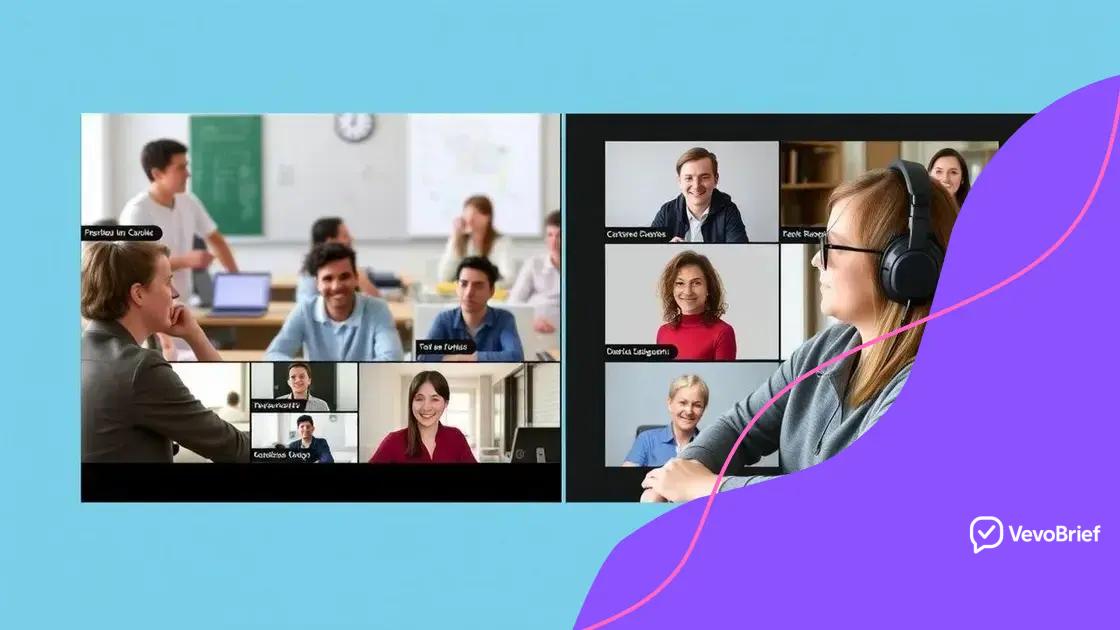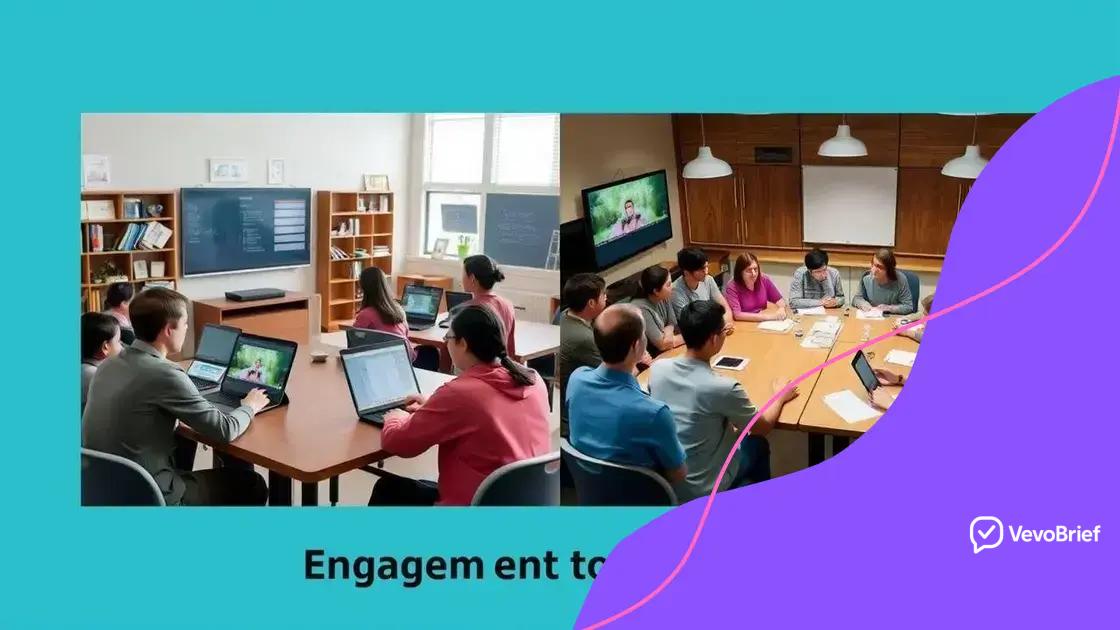Online vs. in-person learning outcomes: What’s the difference?

Online vs. in-person learning outcomes significantly differ in engagement, retention, and flexibility, with online education offering self-paced study and in-person classes fostering immediate interaction and support.
Online vs. in-person learning outcomes has become a hot topic for students and educators alike. Have you ever wondered which method works better for you? Let’s uncover the differences and what they mean for your learning experience.
Understanding online learning outcomes
Understanding online learning outcomes is crucial as more students turn to digital platforms for education. With technological advances, educational experiences have dramatically changed. But how do these outcomes compare to traditional methods of learning?
Key Factors Influencing Online Learning Outcomes
Several elements impact the effectiveness of online learning:
- Engagement: Students’ interaction with content significantly affects learning results.
- Course Structure: Well-organized courses facilitate better understanding and retention.
- Instructor Support: Access to immediate help can improve student satisfaction and outcomes.
- Technology Access: Reliable technology ensures students can participate without barriers.
In addition, online learning outcomes often emphasize flexibility and personalization. Students can learn at their own pace, fitting education into their lifestyles. However, this requires self-discipline. Learning environments that incorporate active participation lead to richer educational experiences.
Measuring Online Learning Success
Assessing online learning outcomes involves various metrics. Common measures include grades, course completion rates, and student engagement statistics. Additionally, feedback through surveys provides insight into the overall student experience, highlighting both strengths and areas for improvement.
Ultimately, understanding and enhancing online learning outcomes is essential for creating effective educational programs. By considering the factors that influence success, educators can develop strategies that ensure all students achieve their goals in digital settings.
Benefits of in-person learning
The benefits of in-person learning are significant and can greatly influence a student’s educational journey. Being physically present in a classroom offers unique advantages that often enhance the learning experience.
Social Interaction
One of the primary benefits of in-person learning is the opportunity for social interaction. Students engage with peers and teachers face-to-face, fostering relationships and developing communication skills.
- Collaboration: Group projects and discussions encourage teamwork.
- Networking: Building connections with classmates can lead to future opportunities.
- Social Skills: Real-time interactions help in developing effective social abilities.
These interactions can lead to a more enriched understanding of the material. Additionally, students often find it easier to stay motivated and engaged in a physical classroom setting.
Access to Resources
In-person learning also provides immediate access to various resources that can aid education. Students benefit from libraries, labs, and other facilities designed to enhance learning.
Classrooms are equipped with technology and resources that support diverse learning styles. Teachers can offer hands-on guidance and tailored feedback. This direct support is invaluable, especially for challenging subjects.
Moreover, the structured environment of a classroom can help students develop better study habits. Routine plays a key role in fostering academic discipline.
Ultimately, the benefits of in-person learning create an environment conducive to growth. From social interaction to resource accessibility, these elements lead to improved educational outcomes and personal development.
Comparing engagement levels

Comparing engagement levels between online and in-person learning reveals important insights about student experiences. Engagement is a key factor in effective education, impacting motivation and retention of information.
Online Learning Engagement
In online environments, student engagement can vary significantly. Many students appreciate the flexibility of learning at their own pace. However, this can lead to challenges like distractions at home and feelings of isolation.
- On-demand resources: Students can access materials anytime, but may miss live interactions.
- Discussion forums: These can encourage participation, yet some students may hesitate to share thoughts.
- Self-directed learning: Allows for personalized paths but requires high motivation levels.
Despite these challenges, effective online courses often incorporate interactive elements to boost engagement. Methods such as live polls, breakout rooms, and gamified content can enhance the online experience.
In-Person Learning Engagement
Conversely, in-person learning typically leads to higher levels of immediate engagement. Face-to-face interactions foster natural communication and collaboration among students and teachers.
Students can ask questions in real time, leading to a more dynamic learning environment. Engagement levels in traditional classrooms benefit from the energy and motivation that come from collective participation.
Moreover, non-verbal cues in in-person settings help teachers gauge student understanding and adapt their teaching strategies.
Understanding the differences in engagement levels between online and in-person learning is crucial. Each format offers unique advantages and challenges, making it essential for educators to tailor their approaches based on the medium and student needs.
Impact on long-term retention
The impact on long-term retention is a critical aspect when comparing online and in-person learning. Understanding how each method affects the ability to remember and apply knowledge is essential for students and educators alike.
Retention in Online Learning
In online learning environments, retention rates can vary significantly. Many students benefit from interactive elements like quizzes and video content, which can enhance memory.
- Multimedia Resources: Engaging videos and infographics can help reinforce concepts.
- Flexible Learning: Students can revisit materials at their own pace, aiding retention.
- Active Participation: Creating study groups online encourages collaborative learning.
However, the lack of direct supervision and potential distractions at home can impede long-term retention. Without regular reminders and structured schedules, students might struggle to retain information over time.
Retention in In-Person Learning
On the other hand, in-person learning often promotes stronger long-term retention. The classroom environment fosters direct interaction with instructors and peers. This dynamic can greatly enhance understanding and memory.
In-person discussions allow for immediate feedback and clarification of concepts. Students benefit from engaging with instructors who can adjust their teaching tactics based on real-time responses. Retention is often higher when students participate actively in discussions and hands-on activities.
Moreover, the structured setting of a traditional classroom helps students create a routine that reinforces learning. Establishing consistent study habits is crucial for maintaining information over the long term.
Ultimately, the methods employed in both online and in-person learning significantly influence long-term retention. Students can maximize their learning outcomes by understanding these impacts and choosing formats that best align with their learning preferences and environments.
Choosing the right format for you
Choosing the right format for learning is important for your educational success. With multiple options available, understanding how to select what suits you best can enhance your learning experience.
Assessing Your Learning Style
Your personal learning style plays a big role in making the best choice. Do you learn best through interactions and hands-on activities, or do you prefer self-paced study? Identifying your strengths can help in this process.
- Visual Learners: Might benefit from online courses that use videos and graphics.
- Auditory Learners: Could favor in-person classes where discussions take place.
- Kinesthetic Learners: Often thrive with hands-on activities in a traditional classroom.
Understanding these preferences first allows you to align your format choice with how you absorb and retain information.
Considering Your Schedule
Your personal schedule is another key factor in choosing the right format. Online learning offers flexibility, catering to busy lifestyles. This means you can study when it’s most convenient for you.
In contrast, in-person learning generally follows a set timetable. This can be beneficial for those who thrive on structured routines. However, think about your commitments and how each format can fit within them.
Another important factor is the level of interaction you desire. In-person classes often facilitate immediate feedback and social connections, which can enhance understanding. Some may find this crucial for staying motivated.
Ultimately, choosing the right format involves a balance between your learning style, schedule, and the interaction level you seek. Evaluating your needs and preferences can lead you to the best educational experience, whether that’s online, in-person, or a combination of both.
FAQ – Frequently Asked Questions about Online vs. In-Person Learning Outcomes
What are the main differences between online and in-person learning?
Online learning offers flexibility and self-paced options, while in-person learning provides direct interaction and structured environments.
How does engagement differ between online and in-person classes?
In-person classes typically foster higher levels of engagement due to immediate feedback and social interaction, while online formats may include interactive elements like forums.
Which format is better for long-term retention?
In-person learning often leads to better long-term retention due to face-to-face interactions and structured support, but effective online methods can also enhance memory.
How should I choose between online and in-person learning?
Consider your learning style, accessibility, schedule, and the level of interaction that you prefer to find the best format for your needs.
